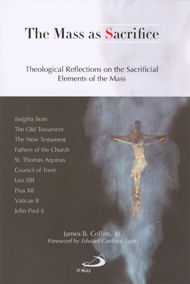
|
Posted February 13, 2008
Book: The Mass as Sacrifice: Theological Reflections on the Sacrificial Elements of the Mass Author: James B. Collins Fathers and Brothers of the Society of St. Paul. N.Y. 2007. Pp. 71 An Excerpt from the Jacket:
An Excerpt from the Book: Praise and Thanksgiving To the Christian mind the idea of “thanksgiving” and “sacrifice” are not foreign to one another. “An offering in the form of thanksgiving was a mode of prayer frequently used by the Christians of early centuries, as they had grown accustomed to in the Eucharist. The many saints and martyrs, who sacrificed their lives for Christ, often gave thanks to God before their sometimes brutal death. An example of this is the “Eucharistic” prayer made by St. Polycarp at the moment of his death: Condemned to be burned alive, he climbed the pyre, and while being tied to the stake he lifted his eyes to heaven and prayed: “O Lord, God Almighty. . .I bless you this day, at this very hour, you have found me worthy to drink of the chalice of your Christ. . .I praise you, I bless you, I glorify you, through the eternal and heavenly High Priest, Jesus Christ.” It was our Lord himself who began the Last Supper giving thanks. The objective of our own thanking and remembering is the sacrifice of Calvary in which Christ offered himself on the cross and redeemed the world: “As far as this concerns an objective remembrance. . .it must be conceded that with this remembrance the sacrifice of Christ is made present.” Msgr. Ronald Knox says that our penitence, our confidence in God, our adoration, all these things, are perfectly in place for us, but it is the characteristic attitude of the Christian people in worshiping God is thankfulness. At the mass and especially during the Eucharistic Prayer, “we are catching our breath at the great deliverance, and thanking God for it.” St. Augustine says that it is right to offer sacrifice to God as a sign of adoration and gratitude, supplication and communion. Every action done so as to cling to God in communion of holiness, and thus achieve blessedness, is a true sacrifice. We must therefore consider the Eucharist as both thanksgiving and praise to the Father as well as “the sacrificial memorial of Christ and his Body; the presence of Christ by the power of his word and of his Spirit.” The Eucharist is also a blessing by which “the Church expresses her gratitude to God for all his benefits, for all that he has accomplished through creation, redemption, and sanctification. Eucharist means first of all ‘thanksgiving.’” The Roman Canon begins with the words: “We come to you, Father, with praise and thanksgiving, through Jesus Christ your Son.” The Eucharist is called a sacrifice of praise by which the Church sings the glory of God in the name of all creation. This sacrifice of praise is possible only through Christ because it is he who unites the faithful to his person, “to his praise, and to his intercession, so that the sacrifice of praise to the Father is offered through Christ and with him, to be accepted in him.” It is through Jesus Christ that the church can offer this sacrifice of praise in thanksgiving for all God has made. Through the Sacrifice of the Mass, all of creation, loved by God, is presented to the Father through the death and the resurrection of his son, Jesus Christ. Epiclesis Bless and approve our offering; make it acceptable to you, an offering in spirit and in truth. Let it become for us the body and blood of Jesus Christ, your only Son, our Lord. The word epiclesis means an “invocation upon,” it is the intercession in which the priest begs the Father to send the Holy Spirit, “so that the offerings may become the body and blood of Christ and that the faithful, by receiving them, may themselves become a living offering to God.” The epiclesis in the Latin text reads: Quam oblationem tu Deus. . .rationabilem acceptablilemque facere digneris. Literally translated it would be, “May God bless our sacrificial gift, may he consecrate, render it valid and spiritual and so worthy of him. The Catechism of the Catholic Church says that together with the anamnesis (which is the prayer of remembrance in which the church calls to mind the Lord’s death, resurrection and ascension into heaven) the epiclesis is at the heart of each sacramental celebration, most especially of the Eucharist. St. John Damascene commenting on the epiclesis says: You ask how the bread becomes the Body of Christ, and the wine . . .the Blood of Christ. I shall tell you: the Holy Spirit comes upon them and accomplishes what surpasses every word and thought . . .Let it be enough for you to understand that it is by the Holy Spirit, just as it was of the Holy Virgin and by the Holy Spirit that the Lord, through and in himself, took flesh. Table of Contents: Chapter 1: Sacrifice and sacred scripture Sacrifice and the Mass Old Testament New Testament Chapter 2: Sacred tradition and the magisterium Fathers of the Church St. Thomas Aquinas The Council of Trent Encyclical Letter by Leo XIII Encyclical Letter by Pius XII Encyclical Letter by Pope Paul VI The Second Vatican Council Chapter 3: The Roman Canon Brief history of the Roman Canon Praise and Thanksgiving Epiclesis The consecration: words of institution The mystery of faith Anamnesis Oblation Intercessions The Last Supper, Calvary, Mary, and the sacrifice of the mass |
|
